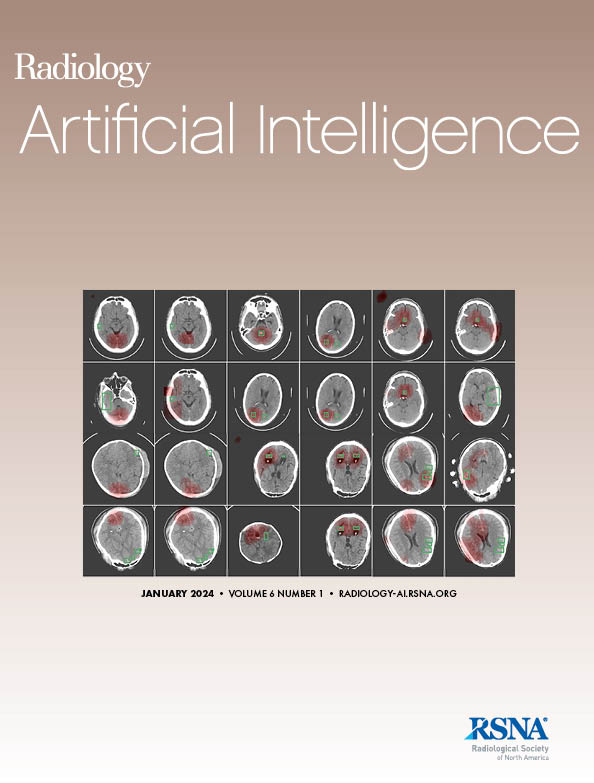Lukas Hirsch, Elizabeth J Sutton, Yu Huang, Beliz Kayis, Mary Hughes, Danny Martinez, Hernan A Makse, Lucas C Parra
下载PDF
{"title":"用于MRI乳腺癌检测与定位的高性能开源AI。","authors":"Lukas Hirsch, Elizabeth J Sutton, Yu Huang, Beliz Kayis, Mary Hughes, Danny Martinez, Hernan A Makse, Lucas C Parra","doi":"10.1148/ryai.240550","DOIUrl":null,"url":null,"abstract":"<p><p>Purpose To develop and evaluate an open-source deep learning model for detection and localization of breast cancer on MRI scans. Materials and Methods In this retrospective study, a deep learning model for breast cancer detection and localization was trained on the largest breast MRI dataset to date. Data included all breast MRI examinations conducted at a tertiary cancer center in the United States between 2002 and 2019. The model was validated on sagittal MRI scans from the primary site (<i>n</i> = 6615 breasts). Generalizability was assessed by evaluating model performance on axial data from the primary site (<i>n</i> = 7058 breasts) and a second clinical site (<i>n</i> = 1840 breasts). Results The primary site dataset included 30 672 sagittal MRI examinations (52 598 breasts) from 9986 female patients (mean age, 52.1 years ± 11.2 [SD]). The model achieved an area under the receiver operating characteristic curve of 0.95 for detecting cancer in the primary site. At 90% specificity (5717 of 6353), model sensitivity was 83% (217 of 262), which was comparable to historical performance data for radiologists. The model generalized well to axial examinations, achieving an area under the receiver operating characteristic curve of 0.92 on data from the same clinical site and 0.92 on data from a secondary site. The model accurately located the tumor in 88.5% (232 of 262) of sagittal images, 92.8% (272 of 293) of axial images from the primary site, and 87.7% (807 of 920) of secondary site axial images. Conclusion The model demonstrated state-of-the-art performance on breast cancer detection. Code and weights are openly available to stimulate further development and validation. <b>Keywords:</b> Computer-aided Diagnosis (CAD), MRI, Neural Networks, Breast <i>Supplemental material is available for this article.</i> See also commentary by Moassefi and Xiao in this issue. © RSNA, 2025.</p>","PeriodicalId":29787,"journal":{"name":"Radiology-Artificial Intelligence","volume":" ","pages":"e240550"},"PeriodicalIF":13.2000,"publicationDate":"2025-09-01","publicationTypes":"Journal Article","fieldsOfStudy":null,"isOpenAccess":false,"openAccessPdf":"https://www.ncbi.nlm.nih.gov/pmc/articles/PMC12464713/pdf/","citationCount":"0","resultStr":"{\"title\":\"High-Performance Open-Source AI for Breast Cancer Detection and Localization in MRI.\",\"authors\":\"Lukas Hirsch, Elizabeth J Sutton, Yu Huang, Beliz Kayis, Mary Hughes, Danny Martinez, Hernan A Makse, Lucas C Parra\",\"doi\":\"10.1148/ryai.240550\",\"DOIUrl\":null,\"url\":null,\"abstract\":\"<p><p>Purpose To develop and evaluate an open-source deep learning model for detection and localization of breast cancer on MRI scans. Materials and Methods In this retrospective study, a deep learning model for breast cancer detection and localization was trained on the largest breast MRI dataset to date. Data included all breast MRI examinations conducted at a tertiary cancer center in the United States between 2002 and 2019. The model was validated on sagittal MRI scans from the primary site (<i>n</i> = 6615 breasts). Generalizability was assessed by evaluating model performance on axial data from the primary site (<i>n</i> = 7058 breasts) and a second clinical site (<i>n</i> = 1840 breasts). Results The primary site dataset included 30 672 sagittal MRI examinations (52 598 breasts) from 9986 female patients (mean age, 52.1 years ± 11.2 [SD]). The model achieved an area under the receiver operating characteristic curve of 0.95 for detecting cancer in the primary site. At 90% specificity (5717 of 6353), model sensitivity was 83% (217 of 262), which was comparable to historical performance data for radiologists. The model generalized well to axial examinations, achieving an area under the receiver operating characteristic curve of 0.92 on data from the same clinical site and 0.92 on data from a secondary site. The model accurately located the tumor in 88.5% (232 of 262) of sagittal images, 92.8% (272 of 293) of axial images from the primary site, and 87.7% (807 of 920) of secondary site axial images. Conclusion The model demonstrated state-of-the-art performance on breast cancer detection. Code and weights are openly available to stimulate further development and validation. <b>Keywords:</b> Computer-aided Diagnosis (CAD), MRI, Neural Networks, Breast <i>Supplemental material is available for this article.</i> See also commentary by Moassefi and Xiao in this issue. © RSNA, 2025.</p>\",\"PeriodicalId\":29787,\"journal\":{\"name\":\"Radiology-Artificial Intelligence\",\"volume\":\" \",\"pages\":\"e240550\"},\"PeriodicalIF\":13.2000,\"publicationDate\":\"2025-09-01\",\"publicationTypes\":\"Journal Article\",\"fieldsOfStudy\":null,\"isOpenAccess\":false,\"openAccessPdf\":\"https://www.ncbi.nlm.nih.gov/pmc/articles/PMC12464713/pdf/\",\"citationCount\":\"0\",\"resultStr\":null,\"platform\":\"Semanticscholar\",\"paperid\":null,\"PeriodicalName\":\"Radiology-Artificial Intelligence\",\"FirstCategoryId\":\"1085\",\"ListUrlMain\":\"https://doi.org/10.1148/ryai.240550\",\"RegionNum\":0,\"RegionCategory\":null,\"ArticlePicture\":[],\"TitleCN\":null,\"AbstractTextCN\":null,\"PMCID\":null,\"EPubDate\":\"\",\"PubModel\":\"\",\"JCR\":\"Q1\",\"JCRName\":\"COMPUTER SCIENCE, ARTIFICIAL INTELLIGENCE\",\"Score\":null,\"Total\":0}","platform":"Semanticscholar","paperid":null,"PeriodicalName":"Radiology-Artificial Intelligence","FirstCategoryId":"1085","ListUrlMain":"https://doi.org/10.1148/ryai.240550","RegionNum":0,"RegionCategory":null,"ArticlePicture":[],"TitleCN":null,"AbstractTextCN":null,"PMCID":null,"EPubDate":"","PubModel":"","JCR":"Q1","JCRName":"COMPUTER SCIENCE, ARTIFICIAL INTELLIGENCE","Score":null,"Total":0}
引用次数: 0
引用
批量引用

 求助内容:
求助内容: 应助结果提醒方式:
应助结果提醒方式:


